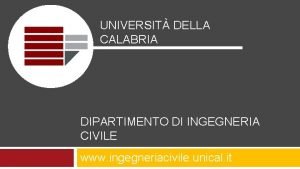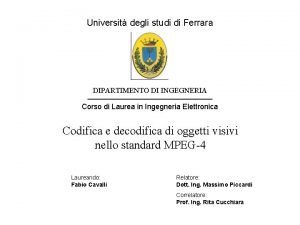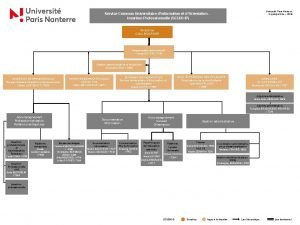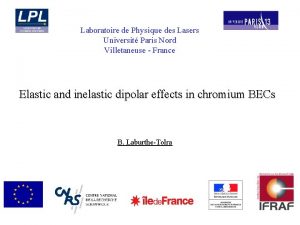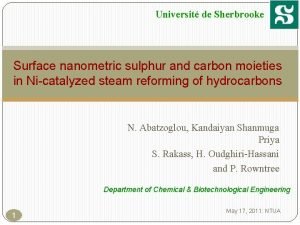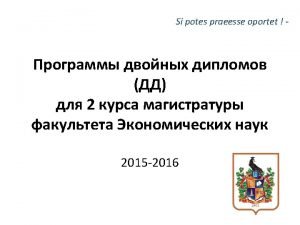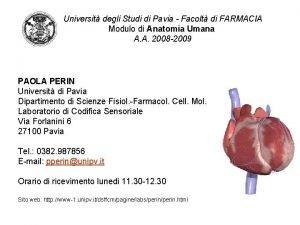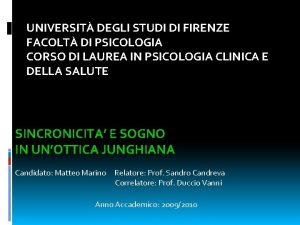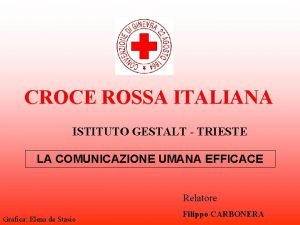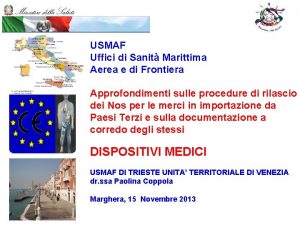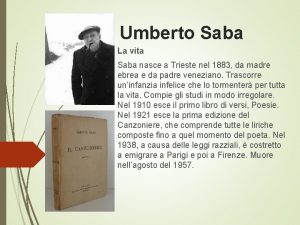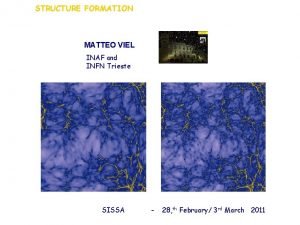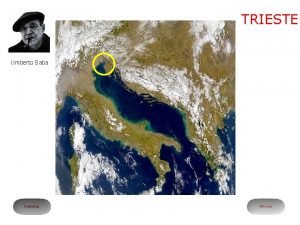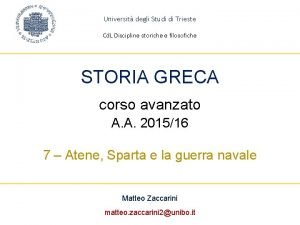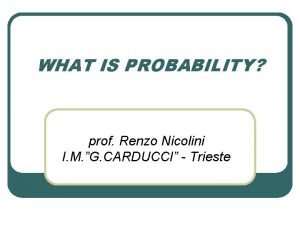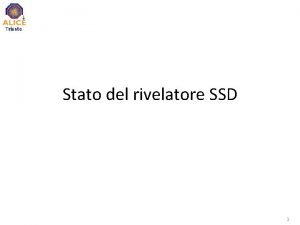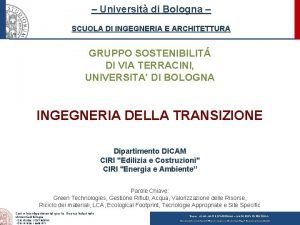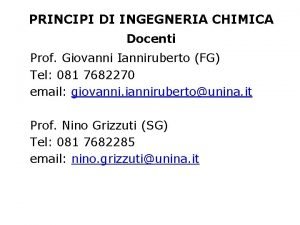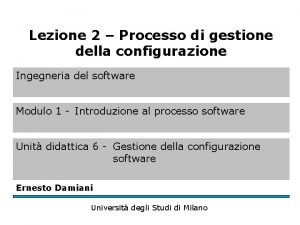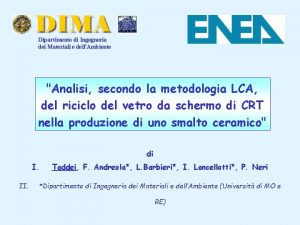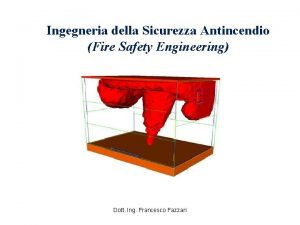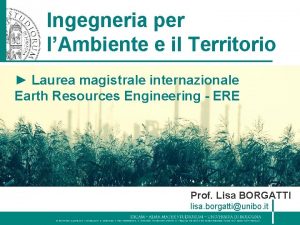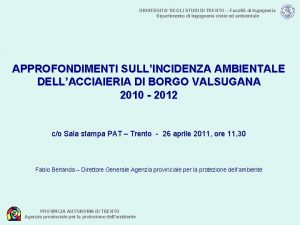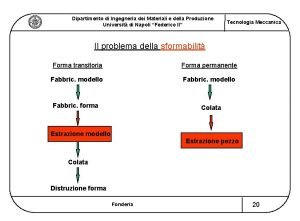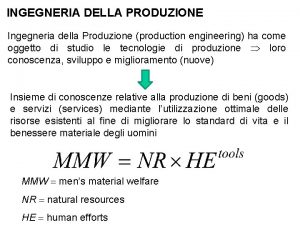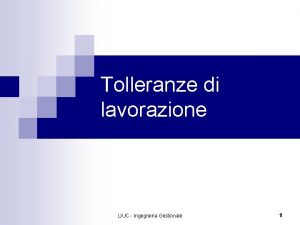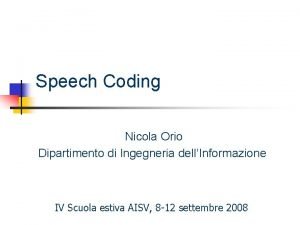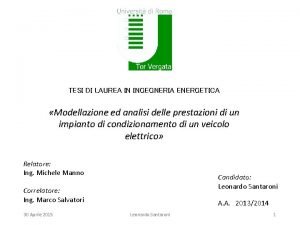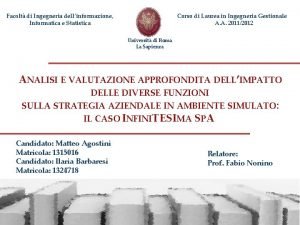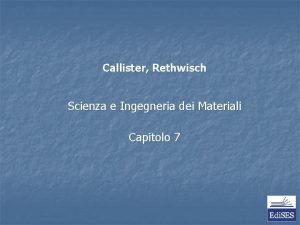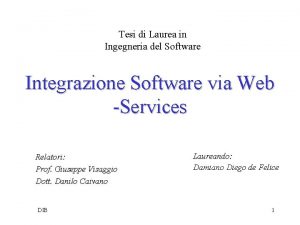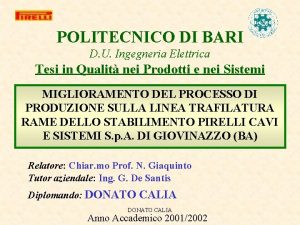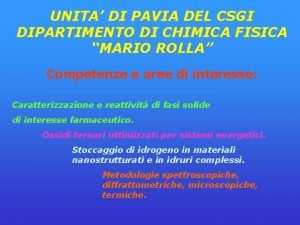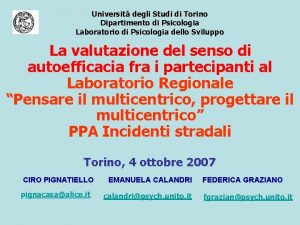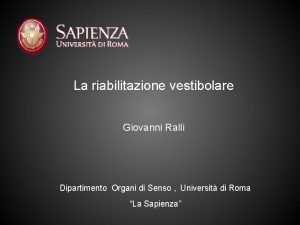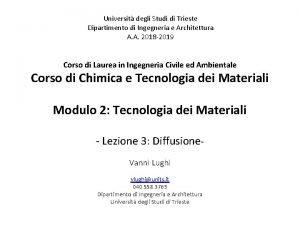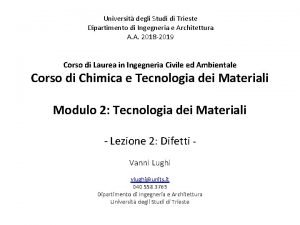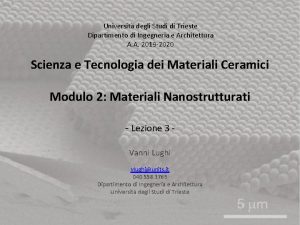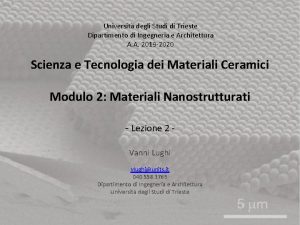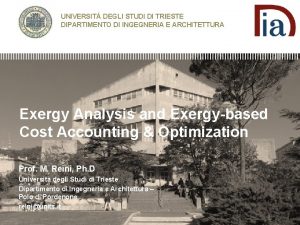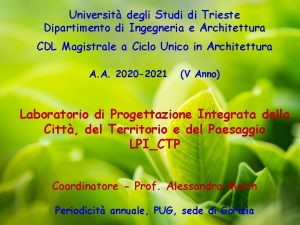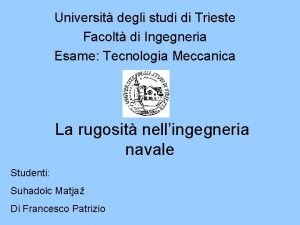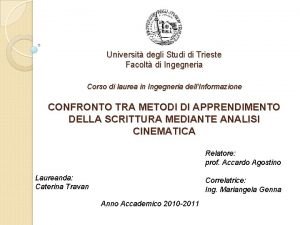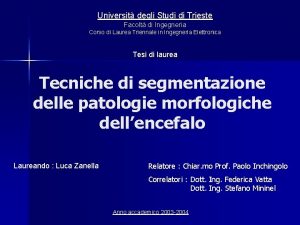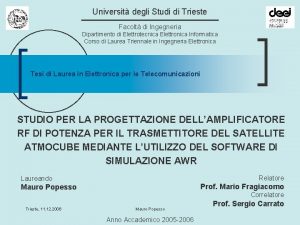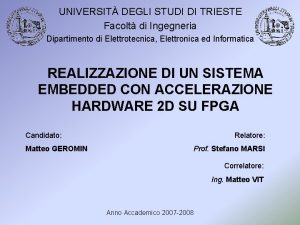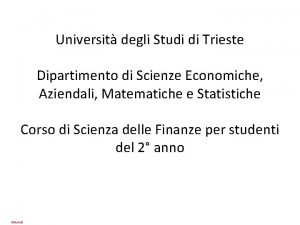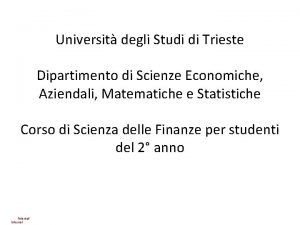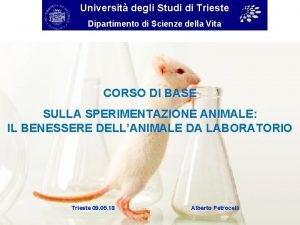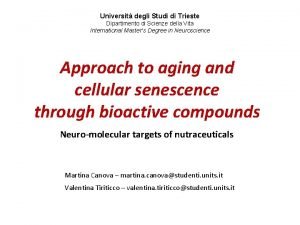Universit degli Studi di Trieste Dipartimento di Ingegneria























































- Slides: 55

Università degli Studi di Trieste Dipartimento di Ingegneria e Architettura A. A. 2018 -2019 Corso di Laurea in Ingegneria Civile ed Ambientale Corso di Chimica e Tecnologia dei Materiali Modulo 2: Tecnologia dei Materiali - Lezione 4: Equilibrio e Diagrammi di Fase Vanni Lughi vlughi@units. it 040 558 3769 Dipartimento di Ingegneria e Architettura Università degli Studi di Trieste

Fasi e Diagrammi di Fase • Fase – porzione di un sistema fisicamente omogenea e compresa all’interno di un volume ben delimitato e potenzialmente separabile • Regola delle Fasi o Regola di Gibbs – Consente di determinare il numero di gradi di libertà (variabili indipendenti), F, di un sistema con un numero di componenti C e di fasi F: 2 + C = F + P • Diagramma di fase – Diagramma che descrive la stabilità termodinamica delle diverse fasi possibili di un sistema, al variare di variabili termodinamiche e della composizione

Diagrammi di Fase Monocomponente Figure 9. 3 (a) Pressure-temperature diagram for H 2 O. The triple point temperature is 273. 0098 K and the triple point pressure is 4. 6 torr. Notice the solidliquid line sloping to the left. At normal pressure (1 atm or 760 torr), the melting temperature is 273 K. A possible scheme for freeze drying is shown as starting with point S and following the dashed line to the left. (b) Pressure-temperature diagram for CO 2. Many researchers are examining the applications of super-critical CO 2 for use as a solvent for applications related to the processing of plastics and pharmaceuticals. . 3

Diagrammi di Fase Monocomponente - uno sguardo alla fase solida - Il caso della silice (ossido di silicio) mostra come nella fase solida possano esserci molte fasi diverse

Solubilità completa, limitata, insolubilità

Solubilità nei solidi Figure 9. 4 (a) Liquid copper and liquid nickel are completely soluble in each other. (b) Solid copper-nickel alloys display complete solid solubility, with copper and nickel atoms occupying random lattice sites. (c) In copper-zinc alloys containing more than 30% Zn, a second phase forms because of the limited solubility of zinc in copper.

Solubilità parziale nei solidi e il concetto di limite di solubilità The solubility of zinc in copper. The solid line represents the solubility limit; when excess zinc is added, the solubility limit is exceeded and two phases coexist. 7

Condizioni per la solubilità completa o Hume-Rothery rules - The conditions that an alloy or ceramic system must meet if the system is to display unlimited solid solubility. Hume-Rothery’s rules are necessary but are not sufficient for materials to show unlimited solid solubility. o Hume-Rothery rules: - Size factor - Crystal structure - Valence - Electronegativity 8

Solubilità completa - un esempio in composti ossidi ceramici - © 2003 Brooks/Cole, a division of Thomson Learning, Inc. Thomson Learning™ is a trademark used herein under license. Figure 9. 7 Mg 0 and Ni 0 have similar crystal structures, ionic radii, and valences; thus the two ceramic materials can form solid solutions.

Rafforzamento per soluzione solida (solid solution strengthening) o Solid-solution strengthening - Increasing the strength of a metallic material via the formation of a solid solution. o Dispersion strengthening - Strengthening, typically used in metallic materials, by the formation of ultra-fine dispersions of a second phase. 10

Rafforzamento per soluzione solida - solid solution strengthening

Rafforzamento per soluzione solida - solid solution strengthening Figure 9. 9 The effect of additions of zinc to copper on the properties of the solid-solution-strengthened alloy. The increase in % elongation with increasing zinc content is not typical of solid-solution strengthening.

Diagrammi di Fase Binari Definitions: o Binary phase diagram - A phase diagram for a system with two components. o Ternary phase diagram - A phase diagram for a system with three components. o Isomorphous phase diagram - A phase diagram in which components display unlimited solid solubility. o Liquidus temperature - The temperature at which the first solid begins to form during solidification. o Solidus temperature - The temperature below which all liquid has completely solidified.

Diagrammi di Fase Binari Esempi di diagrammi binari isomorfi (con solubilità completa) (a) The equilibrium phase diagrams for the Cu-Ni and Ni. O-Mg. O systems. (b) The liquidus and solidus temperatures are shown for a Cu-40% Ni alloy. (c) and (d) Systems with solid solution maxima and minima. (Source: Adapted from Introduction to Phase Equilibria, by C. G. Bergeron, and S. H. Risbud. Copyright © 1984 American Ceramic Society. Adapted by permission. )

Gibbs Rule for Isomorphous Phase Diagram Determine the degrees of freedom in a Cu-40% Ni alloy at (a) 1300 o. C, (b) 1250 o. C, and (c) 1200 o. C. SOLUTION This is a binary system (C = 2). Two components are Cu and Ni. We will assume constant pressure. Therefore, Gibbs rule becomes: 1 + C = F + P (a) At 1300 o. C, P = 1, since only one phase (liquid) is present; C = 2, since both copper and nickel atoms are present. Thus: 1 + C = F + P So, 1 + 2 = F + 1 or F = 2 (b) At 1250 o. C, P = 2, since both liquid and solid are present; C = 2, since copper and nickel atoms are present. Now: 1 + C = F + P So, 1 + 2 = F + 2 or F = 1 (c) At 1200 o. C, P = 1, since only one phase, solid, is present; C = 2, since both copper and nickel atoms are present. Again, 1 + C = F + P So, 1 + 2 = F + 1 or F = 2 15

Gibbs Rule for Isomorphous Phase Diagram Nella regione di coesistenza tra le fasi, vi è un solo grado di libertà nel sistema. Temperatura e composizione non sono indipendenti e il loro legame è rappresentato dalla tie line Figure 9. 12 A hypothetical binary phase diagram between elements A and B. When an alloy is present in a two-phase region, a tie line at the temperature of interest fixes the composition of the two phases. This is a consequence of the Gibbs phase rule, which provides only one degree of freedom.

Example: Compositions of Phases in Cu-Ni Phase Diagram © 2003 Brooks/Cole, a division of Thomson Learning, Inc. Thomson Learning™ is a trademark used herein under license. Determine the composition of each phase in a Cu-40% Ni alloy at 1300 o. C, 1270 o. C, 1250 o. C, and 1200 o. C. (See Figure 9. 13. ) Tie lines and phase compositions for a Cu 40% Ni alloy at several temperatures (for Example 9. 8). 17

Example 9. 8 SOLUTION The vertical line at 40% Ni represents the overall composition of the alloy: - 1300 o. C: Only liquid is present. The liquid must contain 40% Ni, the overall composition of the alloy. - 1270 o. C: Two phases are present. The liquid contains 37% Ni and the solid contains 50% Ni. - 1250 o. C: Again two phases are present. The tie line drawn at this temperature shows that the liquid contains 32% Ni and the solid contains 45% Ni. - 1200 o. C: Only solid is present, so the solid must contain 40% Ni. 18

Example: Solidification of a Cu-40% Ni Alloy © 2003 Brooks/Cole, a division of Thomson Learning, Inc. Thomson Learning™ is a trademark used herein under license. Determine the amount of each phase in the Cu-40% Ni alloy shown in Figure 9. 13 at 1300 o. C, 1270 o. C, 1250 o. C, and 1200 o. C. Figure 9. 13 Tie lines and phase compositions for a Cu-40% Ni alloy at several temperatures 19

Example 9. 10 SOLUTION 20

© 2003 Brooks/Cole, a division of Thomson Learning, Inc. Thomson Learning™ is a trademark used herein under license. Solidification of a Solid-Solution Alloy … and the associated microstructural development Figure 9. 16 The change in structure of a Cu-40% Ni alloy during equilibrium solidification. The nickel and copper atoms must diffuse during cooling in order to satisfy the phase program and produce a uniform equilibrium structure.

© 2003 Brooks/Cole, a division of Thomson Learning, Inc. Thomson Learning™ is a trademark used herein under license. Figure 9. 17 The cooling curve for an isomorphous alloy during solidification. We assume that cooling rates are small so as to allow thermal equilibrium to take place. The changes in slope of the cooling curve indicate the liquidus and solidus temperatures, in this case for a Cu-40% Ni alloy. 25

Nonequilibrium Solidification and Segregation o Segregation - The presence of composition differences in a material, often caused by insufficient time for diffusion during solidification. o Coring - Chemical segregation in cast products, also known as microsegregation or interdendritic segregation. o Homogenization heat treatment - The heat treatment used to reduce the microsegregation caused during nonequilibrium solidification. o Macrosegregation - The presence of composition differences in a material over large distances caused by nonequilibrium solidification. o Spray atomization - A process in which molten alloys or metals are sprayed using a ceramic nozzle. 26

© 2003 Brooks/Cole, a division of Thomson Learning, Inc. Thomson Learning™ is a trademark used herein under license. Figure 9. 18 The change in structure of a Cu-40% Ni alloy during nonequilibrium solidification. Insufficient time for diffusion in the solid produces a segregated structure. 27

© 2003 Brooks/Cole, a division of Thomson Learning, Inc. Thomson Learning™ is a trademark used herein under license. Relationship Between Properties and the Phase Diagram Figure 9. 15 The mechanical properties of copper-nickel alloys. Copper is strengthened by up to 60% Ni and nickel is strengthened by up to 40% Cu.

Diagrammi binari con solubilità parziale

Ricordiamo: Solubilità completa 40

Cosa succede quando la solubiilità non è completa? 41

Cosa succede quando la solubiilità non è completa? Il diagramma cambia, si riscontra un limite di solubilità tra le fasi solide Sviluppo della microstruttura Caso 1: la composizione è inferiore al limite di solubilità alla temperatura di utilizzo (per es. ambiente) 42

Sviluppo della microstruttura Caso 2: la composizione è compresa tra il limite di solubilità alla temperatura di utilizzo (per es. ambiente) e la massima solubilità (in questo esempio: 19%). Precipitazione di una fase fine e dispersa 43

Diagramma binario eutettico Ma guardiamo ora all’intero diagramma. Molto spesso l’equilibrio in sistemi bicomponente include una particolare temperatura e composizionie dette eutettiche, che individuano il punto eutettico. 44

The Eutectic Phase Diagram o Eutectic point – A couple of values of temperature and composition, where three phases exist: one liquid and two solid. A liquid alloy with the eutectic composition transforms, upon cooling, directly to the two solid phases. There are no degrees of freedom. o Solvus - A solubility curve that separates a single-solid phase region from a two-solid phase region in the phase diagram. o Isopleth - A line on a phase diagram that shows constant chemical composition. o Hypoeutectic alloy - An alloy composition between that of the left-hand-side end of the tie line defining the eutectic reaction and the eutectic composition. o Hypereutectic alloys - An alloy composition between that of the right-hand-side end of the tie line defining the eutectic reaction and the eutectic composition. 45

Diagramma binario eutettico Sviluppo della microstruttura Caso 3: composizione eutettica Formazione della microstruttura eutettica o perlitica (tipicamente costituita da fini lamelle) Solidification and microstructure of the eutectic alloy Pb-61. 9% Sn.

Curva di raffreddamento per una composizione eutettica (c)2003 Brooks/Cole, a division of Thomson Learning, Inc. Thomson Learning™ is a trademark used herein under license. Figure 10. 13 The cooling curve for a eutectic alloy is a simple thermal arrest, since eutectics freeze or melt at a single temperature.

(c)2003 Brooks/Cole, a division of Thomson Learning, Inc. Thomson Learning™ is a trademark used herein under license. Figure 10. 14 (a) Atom redistribution during lamellar growth of a lead-tin eutectic. Tin atoms from the liquid preferentially diffuse to the β plates, and lead atoms diffuse to the α plates. (b) Photomicrograph of the lead-tin eutectic microconstituent (x 400). 48

Diagramma binario eutettico Sviluppo della microstruttura Caso 4: composizione ipoeutettica (o ipereutettica) Precipitazione di una fase primaria dal liquido. Alla temperatura eutettica il liquido rimasto si trasforma direttamente nella microstruttura eutettica The solidification and microstructure of a hypoeutectic alloy (Pb-30% Sn).

Figure 10. 17 (a) A hypoeutectic lead-tin alloy. (b) A hypereutectic lead-tin alloy. The dark constituent is the leadrich solid α, the light constituent is the tin-rich solid β, and the fine plate structure is the eutectic (x 400). 50

Equilibrio, microstruttura e proprietà meccaniche di leghe binarie eutettiche Figure 10. 22 The effect of the composition and strengthening mechanism on the tensile strength of leadtin alloys.

(c)2003 Brooks/Cole, a division of Thomson Learning, Inc. Thomson Learning™ is a trademark used herein under license. Esempi di diagrammi e microstrutture in sistemi eutettici Figure 10. 23 the aluminum-silicon phase diagram. 52

Figure 10. 24 Typical eutectic microstructures: (a) needlelike silicon plates in the aluminum silicon eutectic (x 100), and (b) rounded silicon rods in the modified aluminumsilicon eutectic (x 100). 53

(c)2003 Brooks/Cole, a division of Thomson Learning, Inc. Thomson Learning™ is a trademark used herein under license. Nonequilibrium Freezing in the Eutectic System Figure 10. 28 Nonequilibrium solidification and microstruture of a Pb-15% Sn alloy. A nonequilbrium eutectic microconstituent can form if the solidification is too rapid. 55

Ulteriori Possibili Trasformazioni a Tre Fasi (oltre alla trasformazione eutettica) o Peritectic - A three-phase reaction in which a solid and a liquid combine to produce a second solid on cooling. o Eutectic - A three-phase reaction in which a liquid transforms to a two-phase solid. o Monotectic - A three-phase reaction in which one liquid transforms to a solid and a second liquid on cooling. o Miscibility gap - A region in a phase diagram in which two phases, with essentially the same structure, do not mix, or have no solubility in one another. o Metastable miscibility gap - A miscibility gap that extends below the liquidus or exists completely below the liquidus. 56

Ulteriori Possibili Trasformazioni a Tre Fasi (oltre alla trasformazione eutettica)

Ulteriori Possibili Trasformazioni a Tre Fasi (oltre alla trasformazione eutettica)

(c)2003 Brooks/Cole, a division of Thomson Learning, Inc. Thomson Learning™ is a trademark used herein under license. Examples of Phase Diagrams Containing Three-Phase Reactions 59

Dispersion Strengthening • Dispersion strengthening - Increasing the strength of a material by forming more than one phase. • Matrix - The continuous solid phase in a complex microstructure. • Precipitate - A solid phase that forms from the original matrix phase when the solubility limit is exceeded. • Eutectic - A three-phase invariant reaction in which one liquid phase solidifies to produce two solid phases. 60

(c)2003 Brooks/Cole, a division of Thomson Learning, Inc. Thomson Learning™ is a trademark used herein under license. Figure 10. 1 Considerations for effective dispersion strengthening: (a) The precipitate phase should be hard and discontinuous. 61

(c)2003 Brooks/Cole, a division of Thomson Learning, Inc. Thomson Learning™ is a trademark used herein under license. Figure 10. 1 Considerations for effective dispersion strengthening: (b) The dispersed phase particles should be small and numerous. 62

(c)2003 Brooks/Cole, a division of Thomson Learning, Inc. Thomson Learning™ is a trademark used herein under license. Figure 10. 1 Considerations for effective dispersion strengthening: (c) The dispersed phase particles should be round rather than needlelike. 63

(c)2003 Brooks/Cole, a division of Thomson Learning, Inc. Thomson Learning™ is a trademark used herein under license. Figure 10. 1 Considerations for effective dispersion strengthening: (d) Larger amounts of dispersed phase increase strengthening. 64

Intermetallic Compounds o Intermetallic compound - A compound formed of two or more metals that has its own unique composition, structure, and properties. o Stoichiometric intermetallic compound - A phase formed by the combination of two components into a compound having a structure and properties different from either component. o Nonstoichiometric intermetallic compound - A phase formed by the combination of two components into a compound having a structure and properties different from either component. o Ordered crystal structure - Solid solutions in which the different atoms occupy specific, rather than random, sites in the crystal structure. 65

66

(c)2003 Brooks/Cole, a division of Thomson Learning, Inc. Thomson Learning™ is a trademark used herein under license. Intermetallico stechiometrico Intermetallico non-stechiometrico 67

(c)2003 Brooks/Cole, a division of Thomson Learning, Inc. Thomson Learning™ is a trademark used herein under license. Figure 10. 3 The strength and ductility of the intermetallic compound Ti 3 Al compared with that of a conventional nickel superalloy. The Ti 3 Al maintains sits strength to higher temperatures longer than does the nickel superalloy. 68

(c)2003 Brooks/Cole, a division of Thomson Learning, Inc. Thomson Learning™ is a trademark used herein under license. Diagrammi ternari Figure 10. 29 Hypothetical ternary phase diagram. Binary phase diagrams are present at the three faces. 72
 Ingegneria civile unical
Ingegneria civile unical Dipartimento ingegneria trento
Dipartimento ingegneria trento Ingegneria ferrara
Ingegneria ferrara Universit of london
Universit of london Nanterre universit
Nanterre universit Universit
Universit Universit sherbrooke
Universit sherbrooke Rotterdam university economics
Rotterdam university economics Università degli studi di napoli
Università degli studi di napoli Paola perin unipv
Paola perin unipv Università degli studi di firenze psicologia
Università degli studi di firenze psicologia Università degli studi roma tre mascotte
Università degli studi roma tre mascotte Accordo erasmus unige
Accordo erasmus unige Dico al mio cuore
Dico al mio cuore Istituto gestalt trieste
Istituto gestalt trieste Batiskaf trieste
Batiskaf trieste Villaggio del fanciullo trieste
Villaggio del fanciullo trieste Stelle sulla terra trieste
Stelle sulla terra trieste Usmaf trieste
Usmaf trieste Vita di saba
Vita di saba Caritas bilbao
Caritas bilbao Hotel savoia excelsior palace di trieste
Hotel savoia excelsior palace di trieste Z generation trieste
Z generation trieste Trieste umberto saba testo
Trieste umberto saba testo Discipline storiche e filosofiche trieste
Discipline storiche e filosofiche trieste Renzo nicolini
Renzo nicolini Ssdtrieste
Ssdtrieste Scuola di ingegneria e architettura bologna
Scuola di ingegneria e architettura bologna Docenti unina cantone
Docenti unina cantone Gestione della configurazione
Gestione della configurazione Ingegneria dei materiali
Ingegneria dei materiali Regulatory reform (fire safety) order 2005
Regulatory reform (fire safety) order 2005 Usdicam
Usdicam Conversazioni creattive unipd
Conversazioni creattive unipd Facoltà ingegneria trento
Facoltà ingegneria trento Spinte metallostatiche
Spinte metallostatiche Ingegneria machine tools
Ingegneria machine tools Cad ingegneria aerospaziale sapienza
Cad ingegneria aerospaziale sapienza Ingegneria e architettura unibo
Ingegneria e architettura unibo Tolleranza di circolarità
Tolleranza di circolarità Coding ingegneria
Coding ingegneria Tesi ingegneria energetica
Tesi ingegneria energetica Ingegneria dell'informazione informatica e statistica
Ingegneria dell'informazione informatica e statistica Scienza e ingegneria dei materiali callister
Scienza e ingegneria dei materiali callister Pisa ingegneria informatica
Pisa ingegneria informatica Tesi ingegneria del software
Tesi ingegneria del software Unisi ingegneria
Unisi ingegneria Errori ingegneria
Errori ingegneria Ingegneria elettrica bari
Ingegneria elettrica bari Dipartimento di chimica unipv
Dipartimento di chimica unipv Dipartimento di psicologia torino
Dipartimento di psicologia torino Dipartimento di medicina clinica e sperimentale pisa
Dipartimento di medicina clinica e sperimentale pisa Esercizi vestibolo oculari
Esercizi vestibolo oculari Scuola di chicago esponenti
Scuola di chicago esponenti Dipartimento organizzazione giudiziaria
Dipartimento organizzazione giudiziaria Gecos protezione civile
Gecos protezione civile
